Published in Acuity, Vol. 4, pp. 55-64
Download original article (PDF) ![]()
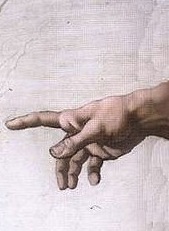 After more than a decade searching for a satisfying analogy that describes the perspective I take when symbolic modelling I’ve finally found one right under my nose. It is the simple and everyday act of pointing.
After more than a decade searching for a satisfying analogy that describes the perspective I take when symbolic modelling I’ve finally found one right under my nose. It is the simple and everyday act of pointing.
It wasn’t until I came across Raymond Tallis’ Michelangelo’s Finger – a whole book devoted to pointing – that I realised just how much mental activity is involved in this physical act. The moment I understood what the recipient of pointing has to do with their attention I thought: ‘That’s what we do. That’s how we model symbolically’.
Before exploring what pointing can reveal for us as symbolic modellers I will examine how pointing works and what both parties have to do with their attention during pointing.
Raymond Tallis explains what is involved in pointing:
What is pointing?
There is the producer (the person doing the pointing); the pointer used by the producer (usually the outstretched hand and index finger); the pointee (that which is pointed out); and, finally, the consumer (the person for whose benefit the pointing is carried out). The producer uses a part of his or her own body to establish an axis that joins the producer with the item being pointed out – with the pointee. The consumer is invited to follow the virtual line with her visual attention until it reaches the pointee. (Tallis, 2010 p. 7)
The index finger is the canonical referential gesture that makes clear what is present in other, less versatile, modes of bodily pointing, using the thumb, the arm as a whole, the elbow, the shoulder, the head, the torso, the eyes and even the foot. (Tallis, 2010 p. 11)
What does the producer do?
She has to be able consciously to use her body as a signal. This implies a special relationship to said body, one that is not found in animals. In addition, she has to have the capacity to be aware of another’s (different) viewpoint. This is a necessary condition of her being aware that she is cognitively advantaged compared with the other person, at least with respect to knowledge of the object being pointed at. The pointer pointing something out to another is to amend a perceived deficit in their knowledge, or experience, or awareness. The usual, and fundamental, occasion for pointing is to correct a lack: to draw attention to something important or at least interesting the other has not noticed or cannot see. In addition, she has to understand that the other’s comparative disadvantage can be set right. (Tallis, 2010 pp. 10-11)
What does the consumer do?
When you point something out to me, I do not consciously adopt the viewpoint of your body. I simply look ‘over there’ to where you are pointing. But I can take this short cut only after I have already acquired the skill that enables me, as it were, to triangulate between you, the object and me. (Tallis, 2010 p. 145)
The consumer has to cast herself in her imagination out of her own body and mentally look along the line drawn in space by the arm and index finger extending from the producer’s body. The consumer, that is to say, has to put herself in the producer’s place. (Tallis, 2010 p. 9)
This is a rather remarkable thing to do. As a consumer, you momentarily adopt the pointer’s perspective, follow the direction of their pointing, identify what is being pointed at (the pointee), and bring that awareness back to your own point of perception. By sharing their perspective your attention is drawn to the object of their attention. Aptly, the word ‘attention’ comes from the Latin meaning ‘stretching towards’. Once you have stretched yourself to what the pointer is pointing at, you can converse about it. (See Figure 1.)
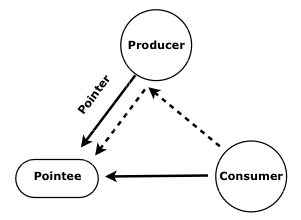
Figure 1: The act of pointing
The mind-body process involved for a consumer of pointing is more than simply experiencing the world “from your own perspective” as in an NLP ‘first position’ (Dilts & DeLozier, 2000). Nor do you become the pointer. It is not “as though you were another individual … in his or her skin” as in an NLP ‘second position’ since you do not give up your own perspective. And it is not an NLP ‘third position’ where you see yourself interacting with the pointer as if you were an outside observer. Instead, as the consumer you notice how the world must look from the pointer’s vantage point and use that to extend your sense of their world while maintaining your own perspective. I propose this is a new and different perceptual position.
Pointing to mind-body phenomena
Tallis describes a situation where the producer points to something that is outside the visual field of the consumer, e.g. “He went that-a-way.” But he does not mention a similar but more common case where people use their gestures and words to point to something within their body or mental space. Pointing to mind-body phenomena happens all the time in everyday conversation. But we are so involved in the content of what we are saying and thinking that we often have only the minutest awareness we are indicating the location and form of symbols in our ‘psychespace’ (as David Grove sometimes called it). And the same goes for the consumer of the pointing.
In a coaching/therapy context clients are continually pointing to things in their inner world of their mind’s eye, ear and feeling. Through their gestures and their metaphors they are pointing out where symbols are in their inner landscape and what form they take. As a coach/therapist I am the ‘consumer’ of the client’s pointing. The only difference with physical-world pointing is that I can never see, hear or feel what they are actually pointing at. Perhaps because of this, in traditional coaching/therapy the information provided by a client’s indicative gestures is mostly ignored. I’m not talking about ‘body language’ and the interpretation thereof. I’m referring to what David Grove called the client’s ‘choreography’ – how the movement of a client’s body references the location and form of the metaphors in their symbolic world. Although I may not be able to see the symbols in a client’s private world, with careful modelling I can know where they are from the client’s perspective and attend to something like what they are attending to.
The physical act of ‘pointing to’ is often used metaphorically to mean ‘pointing out’ something nonphysical. But there is more to it than that. The process of a producer pointing and of a consumer identifying a pointee parallels the process of two people constructing and understanding a metaphor. Metaphors are the pointer that point out experience. Unlike physical items pointed to, we cannot know another person’s experience directly but we can infer it via the intermediary of metaphor (see Figure 2).
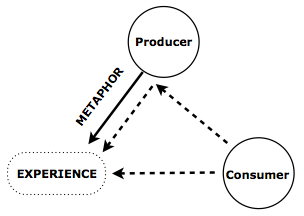
| Pointing | Metaphorising |
| Producer sees item | Person A has an experience |
| Producer uses pointer to point to an item | Person A uses metaphor to describe (point to) an experience |
| Consumer looks at pointer | Person B hears/sees metaphor |
| Consumer infers location of item | Person B infers kind of experience |
| Consumer sees item | Person B has a sense of Person A’s experience |
Symbolic Modelling
What makes the perceptual position of the consumer of pointing so unusual is that I can share the producer/client’s perspective while retaining my own perspective. By unconsciously working out the trigonometry involved I intuitively understand the relative arrangement of the three points, and how the world looks different from each. As a symbolic modeller I bring that intuition into my conscious awareness and make it central to my modelling of the client and their landscape.
The everyday act of pointing can be mapped on to the analogous act of modelling symbolically (see Figure 3).
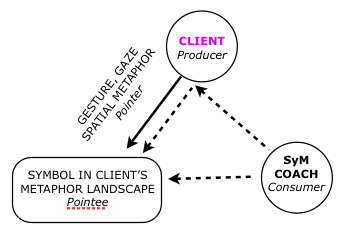
| Pointing | Modelling Symbolically |
| Producer | Client |
| Pointer (body part that points) | Pointer (body part that points) |
| Pointee (item pointed to) | Symbol in client’s inner landscape |
| Consumer | Symbolic modeller |
Figure 3: The act of modelling symbolically
Being able to appreciate another person’s perspective while maintaining your own requires a special kind of modelling skill. Luckily one that almost all of us possess innately.
Previously I had described a symbolic modeller’s perspective as like being in the passenger seat of a car and being driven around an unfamiliar town by someone (the client) who is pointing out all the places they know, “Look, that’s where I went to school” (Lawley, 2007). But in the car metaphor the consumer does not have an independent location. Whereas the pointing analogy beautifully reflects the ‘split attention’ required by a symbolic modeller: I can simultaneously know the client’s perspective and muse on it from another perspective inside, outside or beside the client’s world (Lawley & Tompkins, 2002).
When the facilitator asks a clean question of what has been pointed to a switch occurs. Each clean question ‘points to’ or ‘points out’ some aspect of the client’s metaphor landscape. Metaphorically pointing means “to direct the mind or thought in a certain direction” and that is what every Clean Language question is designed to do (Lawley & Tompkins, 2000). The client now becomes the consumer of the facilitator’s pointing (see Figure 4).
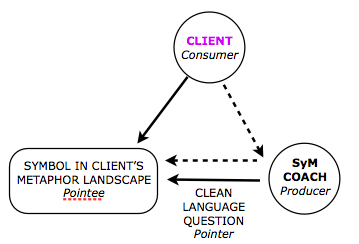
Figure 4: The act of asking Clean Language questions
When the client answers the question the producer-consumer roles switch again – over and over. This very simple oscillation creates an iterative process that forms the spine of a Symbolic Modelling session. This is how Penny Tompkins and I facilitate the development of the client’s embodied psychoactive metaphor landscape.
I know of no other method of therapy or coaching where both the client and facilitator so consistently point to a single inner landscape – the client’s. If you are not trained in a clean approach and you are thinking this seems similar to how you facilitate, I haven’t made the distinction clear. In over 15 years of training this process I have never found anyone who can maintain the consumer- and producer-of-pointing roles consistently, without thoroughly retraining their attention.
The triangulation involved in pointing enables the client, their landscape and the facilitator to engage in what David Grove called a ‘trialogue’; with the most important conversation occurring between client and their landscape.
A skilled clean facilitator can help amplify the pointing to and point out nature of a conversation. To do so they need to do two things: to create a ‘clean environment’ – one with a low level of contaminants from their own inner world; and to ask about the spatial aspects of the client’s verbal and nonverbal metaphors. Since most metaphors have an explicit or implicit spatial aspect, as long as your ears and eyes know what to listen and look for, most clients will give you plenty of opportunity to be a midwife to their metaphor landscape.
Then something quite fascinating happens. The client becomes aware they are pointing out things to them self. The client notices they are simultaneously both the producer and consumer of their own pointing. They become aware they are, to use a phrase introduced by French philosopher Maurice Merleau-Ponty (2005), embodied subjects (see Figure 5).
Gregory Bateson called this a “double description”. The effect is the inclusion of both descriptions into a transcendent third perspective – just as depth perception emerges from binocular vision. I believe most gestures and movements of the body are not communication to another person, but aids to our own thinking process. By noticing how our inner world works clients gain a deep insight into why they act and respond the way they do, and they start to notice choice points – places where their process could go in a different direction and result in a different outcome. When this happens the client is self-modelling (Lawley, 2012).
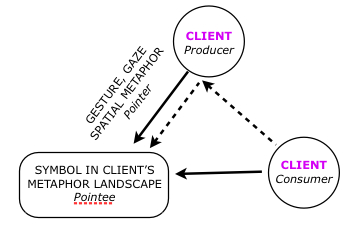
Purpose of pointing
Tallis notes that pointing has two key purposes. First to rectify a perceived deficit in the consumer – we point out something they can’t see or are not yet aware of and we “understand that the other’s comparative disadvantage can be set right”. As a result we momentarily share a perspective, and fulfill the second purpose: we “make a world in common” (Tallis, 2010 p.132). Tallis suggests that the ability to perform this kind of mental gymnastics makes possible the kind of society only humans have:
If one subscribes to the idea that language originated out of gesture, then pointing, as the most versatile of all gestures, and the one that seems closest to the primary, that is to say the referential, function of language, we may argue that it is crucial to the beginning of truly social being (of a kind unknown elsewhere in the animal kingdom), of a collectivization of consciousness upon which community, discourse, civilization and knowledge are based.” (Tallis 2010, p. 131)
The purpose of pointing makes sense when producer and consumer are different people, but what about, as mentioned above, when one person plays both roles? Then the client is, in effect, rectifying a deficit in their own awareness. They become conscious of what before was tacit knowledge, or they have a creative insight. In so doing conscious and subconscious share (momentarily at least) the same perspective. They establish a different kind of relationship. Not Topdog and Underdog. Not Master and Emissary. Not rider and horse. Not adversaries, nor even allies. Instead they are co-inspirers – they form a ‘necessary unity’.[1]
Concluding Points
I am excited about the pointing analogy because people instinctively know what to do when someone points and therefore it should be easy to transfer that skill to facilitating a client session. The challenge for the symbolic modeller is to maintain the alternating consumer and producer perspectives throughout a session. When you develop this skill it is much easier to set aside your own landscape and commit to working within the logic of the client’s landscape, i.e. to work ‘cleanly’.[2]
We will leave the last word to the Buddha who in the Shurangama Sutra says:
It is like when someone points his finger at the moon to show it to someone else. Guided by the finger, that person should see the moon. If he looks at the finger instead and mistakes it for the moon, he loses not only the moon but the finger also.[3]
Notes
1 ‘Topdog vs. Underdog’ a phrase Fritz Perls, the founder of Gestalt Therapy (1969), coined to describe a self-torturing ‘Game People Play’ with themselves.
The ‘Master and his Emissary’ is from the title of an Iain McGilchrist book (2010). For an overview see iainmcgilchrist.com and my three blogs on this fascinating book:
Ent-sprechen says it all
Mutual gaze
Balancing brain hemispheres
“Co-inspiration arises from the conversations we have with each other that are conducted in mutual respect for the other and it provides for a manner of working together in freedom.” Humberto Maturana legacy.oise.utoronto.ca/research/tlcentre/conf2004/process.html
A ‘Necessary Unity’ is taken from the title of a Gregory Bateson book (1979).
2 The nearest scientific description of the pointing perspective I have come across is that pioneered by Maturana and Varela (1992) called “biological phenomenology” or the “view from within” since it attempts to describe the phenomenal inner world of the organism from the outside. Ken Wilber refers to this as one of “8 native perspectives”. In this case, the perspective of an interior (of an “I”) looked at from the outside, i.e. a third-person modelling of a first-person reality, from their perspective. For a detailed description of Ken Wilber’s “8 native perspectives” see his Excerpt D: The Look of a Feeling: The Importance of Post/Structuralism, kenwilber.com/writings/read_pdf/86.
3. Buddha quote from: cttbusa.org/shurangama2/shurangama2_6.asp
References
Bateson, Gregory (1979) Mind and Nature A Necessary Unity – Advances in Systems Theory, Complexity, and the Human Sciences, Hampton Press.
Dilts, Robert & DeLozier, Judith (2000) Perceptual Positions 938-943, Encyclopedia of Systemic NLP and NLP New Coding. nlpuniversitypress.com/html3/SeSh.html
Lawley, James & Tompkins, Penny (2000) Metaphors in Mind: Transformation through Symbolic Modelling, The Developing Company Press.
Lawley, James & Tompkins, Penny (2002) A Model of Musing: The message in a metaphor, Anchor Point, Vol. 16, No. 5.
Lawley, James (2007) The Neurobiology of Space.
Lawley, James (2012) What is Self-Modelling?
McGilchrist, Iain (2010) The Master and his Emissary: The Divided Brain and the Making of the Western World, Yale University Press.
Perls, Fritz (1969) Gestalt Therapy Verbatim, Real People Press.
Maturana, Humberto & Varela, Francisco (1992) The Tree of Knowledge:The Biological Roots of Human Understanding, Shambhala.
Merleau-Ponty, Maurice (2005). Phenomenology of Perception, Routledge.
Tallis, Raymond (2010). Michelangelo’s Finger: An exploration of everyday transcendence, Atlantic Books.
Tompkins, Penny & Lawley, James (1999). Clean Language Without Words, Rapport, Issue 43.
This paper is based on a Developing Group workshop (12 May 2012) and two of my blogs:
The point of pointing
Pointing attention
Marian Way has written an excellent description of a practice group activity based on the ideas in these blogs: Pointing the metaphor we have been looking for. These exercises could be extended by the producer pointing from different positions at different kinds of things using different parts of the body, with and without words.








